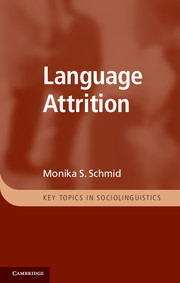Book contents
- Frontmatter
- Contents
- List of figures
- List of tables
- Preface
- Abbreviations
- 1 Introduction
- Part I Linguistic aspects of language attrition
- Part II Extralinguistic aspects of language attrition
- Part III Conducting research on language attrition – preliminary considerations
- Part IV Experimental designs for attrition research – the language attrition test battery
- Part V Coding and analysing the data
- 15 Transcribing and coding free speech: the CHILDES project
- 16 Coding and reporting experimental data
- 17 Interpreting your data: inferential statistics
- 18 Conclusion
- Glossary
- Notes
- References
- Index
15 - Transcribing and coding free speech: the CHILDES project
Published online by Cambridge University Press: 05 June 2012
- Frontmatter
- Contents
- List of figures
- List of tables
- Preface
- Abbreviations
- 1 Introduction
- Part I Linguistic aspects of language attrition
- Part II Extralinguistic aspects of language attrition
- Part III Conducting research on language attrition – preliminary considerations
- Part IV Experimental designs for attrition research – the language attrition test battery
- Part V Coding and analysing the data
- 15 Transcribing and coding free speech: the CHILDES project
- 16 Coding and reporting experimental data
- 17 Interpreting your data: inferential statistics
- 18 Conclusion
- Glossary
- Notes
- References
- Index
Summary
There are many features which we may want to transcribe and code in free data, but what is the best system of transcription that will allow us to do so? This chapter will discuss a widely used system called CHAT.
In the previous chapter I addressed the problem of how to analyse free speech. I proposed that it is important to analyse naturalistic speech data from the point of view of complexity, accuracy and fluency. That is, each utterance should be coded for its lexical, morphological, morphosyntactic and syntactic complexity and accuracy, each disfluency and hesitation should be marked, and overall lexical diversity should be assessed.
You can imagine how quickly the wrong coding system can make an entirely unreadable mess of your data. However, do not do what I did when I wrote my Ph.D., which was to print out all of my data (comprising some 175,000 words) multiple times, and to go through them with different coloured text markers to code features such as singular and plural noun phrases, main clauses, subordinate clauses, different tenses, different genders of noun phrases, different cases, and so on, subsequently counting them all by hand. Instead, I recommend that you use the system of coding and transcriptions which has been developed by Brian MacWhinney in the CHILDES (Child Language Data Exchange System) project (http://childes.psy.cmu.edu; see also MacWhinney, 2000).
- Type
- Chapter
- Information
- Language Attrition , pp. 199 - 207Publisher: Cambridge University PressPrint publication year: 2011



